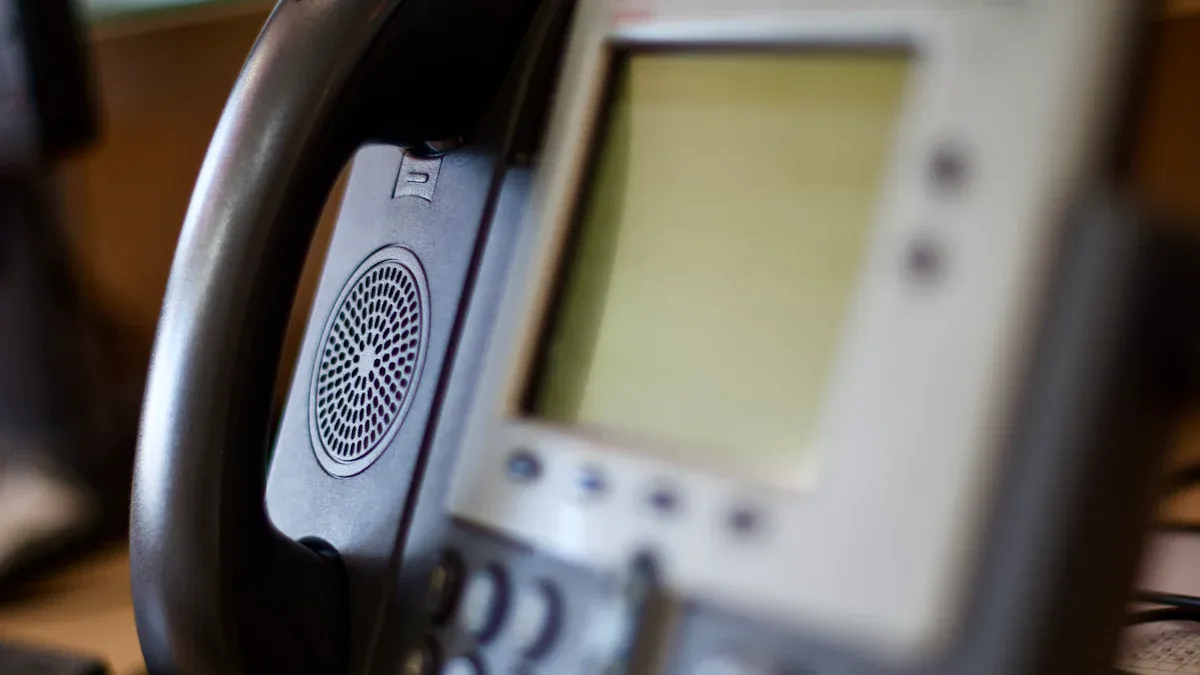
Analog Telephone Adaptors (ATAs) have revolutionized telephony by seamlessly connecting traditional analog systems with modern IP networks. Their ability to modernize communication systems while keeping costs low has made them an indispensable tool for businesses and homes. By eliminating the need for costly hardware and maintenance, ATAs enable users to scale their systems effortlessly. The Analog Telephone Adaptor Cost-Effective FXS VoIP Gateway JWDT1000-1S/2S exemplifies this innovation, offering a practical solution for integrating analog Industrial Telephone systems, Marine Industrial Telephone setups, and even ATEX Explosion Proof Telephone environments into cutting-edge VoIP networks.
Understanding Analog Telephone Adaptors (ATAs)

What Are ATAs and How Do They Work?
Analog Telephone Adaptors (ATAs) are devices that connect traditional analog telephony equipment, such as landline phones and fax machines, to modern IP networks. They enable users to leverage Voice over Internet Protocol (VoIP) technology without replacing their existing analog devices. ATAs operate by converting analog signals into digital data for transmission over the internet and vice versa. This process ensures seamless communication between legacy systems and advanced VoIP platforms.
The technical benchmarks of ATAs highlight their operational principles. For example:
| Component/Aspect | Description |
|---|---|
| Protocols | VoIP services utilize RTP for voice data transmission and SIP for establishing connections. |
| Functionality | ATAs connect analog devices to IP networks, allowing internet communication while using existing equipment. |
| Conversion Process | Converts analog signals to digital and vice versa, facilitating communication over the internet. |
| Connection Types | Typically connects via RJ-11 for phones and RJ-45 for VoIP/Ethernet, directly to a network device. |
| Voice Codec | Used for encoding and decoding voice signals during transmission. |
| Quality of Service (QoS) | Routers prioritize RTP packets to ensure voice quality over data traffic. |
These features make ATAs an essential tool for integrating traditional telephony with modern communication systems.
Key Features of the Analog Telephone Adaptor Cost-Effective FXS VoIP Gateway JWDT1000-1S/2S
The Analog Telephone Adaptor Cost-Effective FXS VoIP Gateway JWDT1000-1S/2S stands out due to its robust features. It supports one or two FXS ports, making it suitable for small offices and home offices. Its built-in high-speed NAT router ensures excellent voice quality during calls. The device also supports SIP and IMS protocols, ensuring compatibility with leading softswitches and IP PBXs.
User-friendliness is another key feature. The JWDT1000-1S/2S simplifies deployment with automatic provisioning and centralized management. This design allows users with minimal technical expertise to set up and maintain their systems effortlessly. Additionally, its support for T.38 fax ensures reliable fax transmission, further enhancing its versatility.
Benefits of Using ATAs in Modern Telephony
The adoption of ATAs is growing due to their numerous benefits. The increasing use of VoIP technology and broadband expansion has driven demand for these devices in both residential and business settings. Over 30% of U.S. companies now use VoIP systems, highlighting this trend. Businesses switching to VoIP report significant cost savings and improved operational efficiency.
ATAs offer several advantages:
- They reduce communication expenses compared to traditional phone services.
- They provide flexibility, enabling users to make calls from anywhere with an internet connection.
- Advanced VoIP features support collaboration and multichannel communication.
The Analog Telephone Adaptor Cost-Effective FXS VoIP Gateway JWDT1000-1S/2S exemplifies these benefits. Its cost-effective design and compatibility with existing systems make it an ideal choice for modern telephony needs.
Solving Legacy Telephony Challenges with ATAs

Bridging Analog Systems with VoIP Networks
Analog systems often struggle to keep up with the demands of modern communication. Analog Telephone Adaptors (ATAs) address this challenge by acting as a bridge between traditional telephony equipment and advanced VoIP networks. These devices convert analog signals into digital data, enabling seamless communication over the internet. This capability allows businesses and homes to retain their existing analog devices, such as telephones and fax machines, while benefiting from the flexibility and cost savings of VoIP technology.
The Analog Telephone Adaptor Cost-Effective FXS VoIP Gateway JWDT1000-1S/2S exemplifies this functionality. It ensures compatibility with legacy devices while supporting SIP and IMS protocols, making it a versatile solution for integrating analog systems with cloud-based communication platforms. By enabling this integration, ATAs eliminate the need for costly infrastructure upgrades, making them an essential tool for modernizing telephony systems.
Cost-Effectiveness and Scalability
ATAs offer significant cost advantages over traditional telephony systems. They reduce operational expenses by leveraging internet-based communication, which often comes with lower monthly fees and flat-rate pricing options. Additionally, ATAs provide scalability, allowing users to expand their communication systems without incurring substantial costs.
A comparative analysis highlights the cost-effectiveness of ATAs in modern network implementations:
| Category | POTS Costs | VoIP Costs |
|---|---|---|
| Initial Setup Costs | Lower initial costs for physical lines and devices. | Higher upfront costs for IP phones and adapters. |
| Ongoing Operational Costs | Higher monthly fees and long-distance charges. | Lower monthly costs with potential flat-rate pricing. |
| Cost-effectiveness for Sizes | Less cost-effective for small businesses. | More cost-effective for small to large businesses. |
The Analog Telephone Adaptor Cost-Effective FXS VoIP Gateway JWDT1000-1S/2S further enhances cost-effectiveness by supporting one or two FXS ports, making it ideal for small offices and home offices. Its affordability and scalability make it a practical choice for businesses looking to optimize their communication systems.
Simplified Configuration and Maintenance
One of the key advantages of ATAs is their ease of configuration and maintenance. Unlike traditional telephony systems, which often require specialized technical expertise, ATAs are designed with user-friendliness in mind. Features such as automatic provisioning and centralized management simplify the setup process, allowing users to deploy and manage their systems with minimal effort.
The JWDT1000-1S/2S stands out in this regard. Its automatic provisioning feature eliminates the need for manual configuration, while its centralized management system streamlines maintenance tasks. These capabilities make it an excellent choice for users with limited technical knowledge, enabling them to focus on their core activities without worrying about complex telephony setups.
How the JWDT1000-1S/2S Enhances Communication Systems
The JWDT1000-1S/2S offers several features that enhance communication systems compared to legacy devices. Its seamless connectivity between IP telephony and analog devices ensures a smooth transition to modern communication platforms. Additionally, it supports T.38 fax, enabling reliable fax transmission over IP networks.
A comparison of the JWDT1000-1S/2S with legacy devices highlights its advantages:
| Feature | JWDT1000-1S/2S | Legacy Devices |
|---|---|---|
| Connectivity | Seamless between IP Telephony and legacy devices | Limited connectivity options |
| Fax over IP | Yes | Not typically supported |
| Automatic Provisioning | Yes | Manual setup required |
| Centralized Management | Yes | Often decentralized |
| Voice Quality | High | Variable |
| Ideal Use Cases | SOHO, small enterprises, personal use | Limited to specific environments |
These features make the Analog Telephone Adaptor Cost-Effective FXS VoIP Gateway JWDT1000-1S/2S a valuable asset for businesses and homes. Its ability to integrate legacy systems with modern networks, combined with its user-friendly design and cost-effective operation, ensures that users can enjoy the benefits of advanced telephony without abandoning their existing equipment.
Practical Applications for Businesses and Homes

Integrating Analog Phones with Cloud-Based Systems
Analog Telephone Adaptors (ATAs) play a pivotal role in connecting traditional analog phones to cloud-based systems. These devices enable seamless communication by converting analog signals into digital data, which can be transmitted over the internet. Features like voice quality optimization, cloud provisioning, and robust security ensure that the integration process is smooth and reliable. This capability allows businesses and homes to retain their existing analog equipment while accessing the advanced features of cloud-based telephony.
For example, the Analog Telephone Adaptor Cost-Effective FXS VoIP Gateway JWDT1000-1S/2S provides a cost-effective solution for integrating legacy devices with modern communication platforms. Its compatibility with SIP and IMS protocols ensures interoperability with leading cloud systems, making it an ideal choice for users seeking to modernize their telephony infrastructure without significant investment.
Tip: Businesses can enhance their communication systems by leveraging ATAs to bridge the gap between analog devices and cloud-based solutions, ensuring scalability and cost efficiency.
Enhancing Emergency Communication Setups
Emergency communication systems often rely on analog devices due to their reliability and simplicity. ATAs enhance these setups by enabling integration with VoIP networks, which offer additional features like call routing, redundancy, and remote management. This ensures that emergency communication remains operational even during network disruptions.
The JWDT1000-1S/2S is particularly suited for such applications. Its high-speed NAT router ensures excellent voice quality, while its support for T.38 fax allows for reliable transmission of critical documents. These features make it an invaluable tool for emergency setups in hospitals, schools, and other institutions where uninterrupted communication is essential.
Supporting Hybrid Telephony Environments
Hybrid telephony environments combine analog and digital communication systems, allowing businesses to transition to VoIP while maintaining their existing analog devices. ATAs facilitate this transition by providing seamless connectivity between the two systems. They support various communication platforms, including Unified Communications as a Service (UCaaS) solutions, enabling businesses to integrate analog systems with digital infrastructures effectively.
Key benefits of ATAs in hybrid environments include:
- Compatibility with both analog and VoIP devices.
- Remote management and updates for enhanced operational efficiency.
- Cost savings by eliminating the need for complete system overhauls.
The JWDT1000-1S/2S excels in hybrid setups, offering centralized management and automatic provisioning to simplify deployment. Its ability to support one or two FXS ports makes it ideal for small to medium-sized businesses transitioning to modern telephony systems.
Use Cases for the JWDT1000-1S/2S in Small Offices and Homes
The JWDT1000-1S/2S is designed to meet the diverse needs of small offices and home users. Its affordability and ease of use make it a practical choice for those looking to enhance their communication capabilities without extensive infrastructure changes. Here are some common use cases:
-
Small Offices:
Small businesses can save up to 45% on communication costs by switching to VoIP systems. The JWDT1000-1S/2S enables these businesses to retain their analog phones while accessing advanced VoIP features, improving productivity and reducing operational expenses. -
Home Offices:
Remote workers benefit from the device’s ability to integrate analog phones with cloud-based systems. This ensures reliable communication and access to VoIP features like call forwarding and voicemail-to-email. -
Startups:
Startups can reduce initial telephony costs by up to 90% by using ATAs. The JWDT1000-1S/2S provides a scalable solution that grows with the business, making it an ideal choice for entrepreneurs. -
Personal Use:
Home users can leverage the device to connect their analog phones to VoIP networks, enabling cost-effective international calls and access to modern telephony features.
Note: The JWDT1000-1S/2S stands out as a versatile solution for various application environments, offering reliability, cost savings, and ease of use.
Configuring and Optimizing ATAs

Step-by-Step Guide to Setting Up the JWDT1000-1S/2S
Setting up the JWDT1000-1S/2S is straightforward and requires minimal technical expertise. Follow these steps to ensure a smooth installation:
- Unbox and Inspect: Verify that all components, including the power adapter, Ethernet cable, and user manual, are present.
- Connect the Device: Use an RJ-11 cable to connect your analog phone or fax machine to the FXS port on the ATA. Then, connect the ATA to your router using an Ethernet cable.
- Power On: Plug in the power adapter and turn on the device. Wait for the indicator lights to stabilize.
- Access the Configuration Interface: Open a web browser and enter the ATA’s IP address (found in the user manual). Log in using the default credentials.
- Configure Network Settings: Set up the device to work with your network. Choose between DHCP or static IP settings based on your network requirements.
- Register with VoIP Provider: Enter the SIP credentials provided by your VoIP service. Save the settings and test the connection.
- Test the Setup: Make a test call to ensure the device is functioning correctly.
Tip: Regularly update the firmware to maintain compatibility with the latest VoIP protocols.
Tips for Optimizing Performance and Compatibility
To maximize the performance of the JWDT1000-1S/2S, consider these optimization tips:
- Prioritize Voice Traffic: Enable Quality of Service (QoS) settings on your router to prioritize VoIP traffic over other data.
- Use Compatible Codecs: Select codecs like G.711 or G.729 for optimal voice quality and bandwidth efficiency.
- Minimize Network Interference: Place the ATA away from devices that emit electromagnetic interference, such as microwaves or cordless phones.
- Regular Maintenance: Periodically check cables and connections to prevent signal degradation.
- Test Fax Compatibility: For fax machines, enable T.38 protocol to ensure reliable transmission.
Note: Consult the user manual for advanced configuration options tailored to your specific telephony needs.
Troubleshooting Common ATA Issues
Even with reliable devices like the JWDT1000-1S/2S, occasional issues may arise. The table below outlines common troubleshooting methods validated by technical support case studies:
| Troubleshooting Method | Description |
|---|---|
| Voltage Measurement | Measure the voltage of the phone line to ensure it meets the requirements of legacy alarm panels. |
| Configuration Adjustment | Adjust the voltage settings on the ATA to ensure compatibility with alarm systems. |
| VOIP Quality Settings | Optimize settings to reduce latency, echo, and codec issues that affect call quality. |
If issues persist, verify the device’s firmware version and update it if necessary. Additionally, ensure that the SIP credentials are correctly entered and that the network connection is stable.
Pro Tip: Keep a log of error messages or unusual behavior to assist technical support in diagnosing and resolving issues efficiently.
Analog Telephone Adaptors, like the Analog Telephone Adaptor Cost-Effective FXS VoIP Gateway JWDT1000-1S/2S, transform telephony by bridging analog systems with modern VoIP networks. They offer cost-effective solutions for businesses and homes, enabling users to retain legacy equipment while accessing advanced communication features. These devices future-proof telephony systems, ensuring scalability and compatibility with evolving technologies.
FAQ
What is the primary purpose of an Analog Telephone Adaptor (ATA)?
An ATA connects analog devices, such as telephones and fax machines, to modern VoIP networks by converting analog signals into digital data for internet communication.
Can the JWDT1000-1S/2S support multiple devices simultaneously?
Yes, the JWDT1000-1S/2S supports one or two FXS ports, allowing users to connect and operate multiple analog devices simultaneously.
Tip: Use both ports to maximize the device’s functionality in small office setups.
Is the JWDT1000-1S/2S compatible with all VoIP providers?
The JWDT1000-1S/2S supports SIP and IMS protocols, ensuring compatibility with most leading VoIP providers and cloud-based communication platforms.
Note: Verify your VoIP provider’s requirements for seamless integration.


